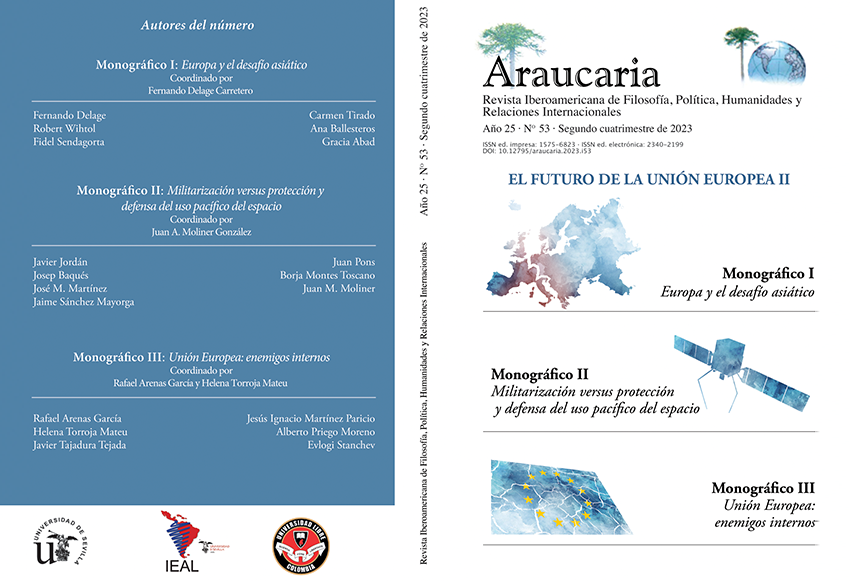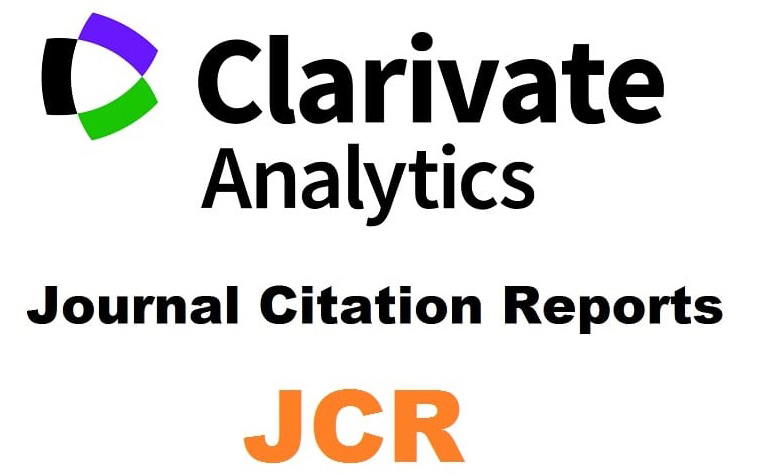Dimensión ética y moral de posibles conflictos militares en el espacio exterior
Economic and technological dimension of Outer Space
DOI:
https://doi.org/10.12795/araucaria.2023.i53.13Palavras-chave:
Espacio Exterior, Naturaleza Dual, Guerra Espacial, Usos Pacíficos, Ética militar.Resumo
El uso del espacio exterior, denominación que se utilizará en este trabajo, aunque también es habitual la de espacio ultraterrestre, nació y se desarrolló por el interés militar de las dos grandes potencias implicadas y siempre ha estado presente desde que se inició la Era Espacial. En las últimas décadas la militarización del espacio ha aumentado de forma notable, amenazando el uso pacífico del mismo que se pretendió fuera el interés principal de su regulación internacional. En paralelo, también se han incrementado hasta extremos increíbles los servicios y aplicaciones civiles con una rapidez y amplitud, gracias a los nuevos desarrollos tecnológicos, no prevista cuando se firmó el Tratado del Espacio Exterior. Estas actividades se han expandido hasta el punto de que la humanidad depende de muchas aplicaciones, basadas en el espacio exterior y en gran parte de naturaleza dual civil y militar, que sustentan importantes actividades económicas globales. El riesgo del uso de la fuerza en o desde el espacio ultraterrestre no puede ser obviado y la reflexión desde la ética militar se hace necesaria para evitar que un bien común de toda la humanidad se convierta en escenario de conflictos y guerras.
Downloads
Referências
- ABC News, “Fake asteroid? NASA expert identifies mystery object as old rocket”, October 12. https://www.abc.net.au/news/2020-10-12/fake-asteroid-nasa-expert-ids-mystery-object-as-old-rocket/12752996
- Coleman, S. “Introduction to Military Ethics in Space”, en Coleman, N. (ed.). Military Space Ethics, Hampshire: Howgate Publishing Limited, 2022.
- Dolman, E. Astropolitik: Classical Geopolitics in the Space Age. London: Frank Cass, 2002.
- Estado Mayor de la Defensa. Entorno operativo 2035. Madrid: Ministerio de Defensa, 2019.
- Estrategia de Seguridad Aeroespacial Nacional 2019. Madrid: Departamento de Seguridad Nacional. https://www.dsn.es/documento
- Hestermann-Crane, A. “Ethical Considerations on the Challenges of the Dual-use Satellite Problem”, en Coleman, N. (ed.). Military Space Ethics, Hampshire: Howgate Publishing Limited, 2022.
- Ingeniería.es. “Satélite de posicionamiento global y sus tres principales competidores”, https://www.ingenieria.es/satelite-de-posicionamiento
- Institute of Medicine. “Health Standards for Long Duration and Exploration Space Flight”. Washington DC: The National Academies Press, 2014.
- Kessler, D. y Cour-Palais, B. “Collision frequency of artificial satellites. The creation of a debris belt”, Journal of Geophysical Research (83) 1978.
- Miller, C. “Future War. Will it be conducted by Robots or Space Marines?”, en Coleman, N. (ed.). Military Space Ethics, Hampshire: Howgate Publishing Limited, 2022.
- Mundo oculto. “Guerra espacial: Como el Pentágono planea defender la última frontera”. 25 mayo 2021. https://mundooculto.es/2021/05/guerra-espacial-pentagono-planea.defender-la-ultima-frontera
- NASA. https://www.nasa.gov/specials/artemis-accords/index.html
- O´Connor, A. et al. Economic Benefits of the Global Positioning System (GPS) Final Report”. RIT International, June 2019.
- Pons, J. Atalayar, 9 septiembre 2022. https://atalayar.com/content/el-jemad-advierte-de-la-tendencia-militarizar-el-espacio-ultraterrestre
- Remuss, L. “The Need for Counter Space Terrorism – A European Perspective”. ESPI perspectives, 17. European Space Policy Institute, 2017.
- “Salvaje Oeste”, Informe Semanal de Política Exterior, Núm. 1255. 13 de diciembre de 2021.
- Sparrow, R. “Drones, courage, and military culture”, en Lucas, G. (ed.). Routledge Handbook of Military Ethics, New York: Rouledge, 2022.
- Trump, D.J. “Executive Order on Encouraging International Support for the Recovery and Use of Space Resources (2020)”. https://www.whitehouse.gov/presidential-actions/executive-order-encouraging-international-support-recovery-use-space-resources/
- Unión Europea. Apoyo de la propuesta de la Unión de un Código internacional de conducta para las actividades en el espacio ultraterrestre. Decisión 2012/281/PESC del Consejo, 29 de mayo de 2012.
- Union of Concerned Scientists “Satellite Database. https://www.ucsusa.org/resources/satellite-database
- United Nations. La cuestión del uso pacífico de espacio exterior. Resolución 1348 (XIII) de la Asamblea General. 13 diciembre 1958.
- United Nations. Treaty Banning Nuclear Tests in the Atmosphere, in Outer Space, and Under Water, 1963.
- United Nations. Treaty on Principles Governing the Activities of States in the Exploration and Use of Outer Space, including the Moon and Other Celestial Bodies. 1967.
- United Nations. UN Guidelines on the long-term Sustainability of Outer Space Activities, julio 2019. https://undocs.org/A/AC.105/C.1/L.366
- United Nations. Prevención de la carrera armamentista en el espacio ultraterrestre. Resolución de la Asamblea General A/RES/76/37. 16 de diciembre de 2020.
- United Nations. Compromiso de no ser el primero en emplazar armas en el espacio ultraterrestre. Resolución de la Asamblea General A/RES/75/35. 16 de diciembre de 2020.
- United Nations. Reducción de las amenazas relacionadas con el espacio mediante normas, reglas y principios de conductas responsables. Resolución de la Asamblea General A/RES/76/231. 30 de diciembre de 2021.
- “US talk of New Pearl Harbour”, London Times, 4 November 1957.
- Verrier, K. “The Problems posed by non-State groups and Rogue States”, en Coleman, N. (ed.). Military Space Ethics, Hampshire: Howgate Publishing Limited, 2022.
- West, J. “From Peaceful Uses to Warfighting: The Dangers of the Military Era in Space”, en Coleman, N. (ed.). Military Space Ethics, Hampshire: Howgate Publishing Limited, 2022.
- Woomera Manual, 2020. https://law.adelaide.edu.au/woomera
Downloads
Publicado
Como Citar
Edição
Seção
Licença
Las ediciones impresa y electrónica de esta Revista son editadas por el Secretariado de Publicaciones de la Universidad de Sevilla, siendo necesario citar la procedencia en cualquier reproducción parcial o total.Salvo indicación contraria, todos los contenidos de la edición electrónica se distribuyen bajo una licencia de uso y distribución “Creative Commons Atribución-NoComercial-SinDerivar 4.0 Internacional”








